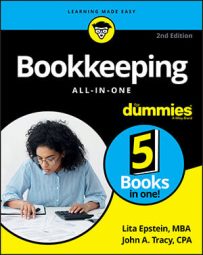 ©By VectorKnight/Shutterstock.com
©By VectorKnight/Shutterstock.com3 financial areas to balance: Assets, liabilities and equity
Every business has three key financial parts that you, as the bookkeeper, must keep in balance: assets, liabilities, and equity. Following are the descriptions of these three terms:
-
Assets include everything the company owns, such as cash, inventory, buildings, equipment, and vehicles.
-
Liabilities include everything the company owes to others, such as vendor bills, credit card balances, and bank loans.
-
Equity includes the claims owners have on the assets based on their portion of ownership in the company.
The formula for keeping your books in balance involves these three elements:
Assets = Liabilities + Equity
The balance sheet and income statement
Most businesses prepare at least two key financial reports, the balance sheet and the income statement, to show them to company outsiders, including the financial institutions from which the company borrows money and the company’s investors.
-
The balance sheet is a snapshot of your business’s financial health as of a particular date. The balance sheet should show that your company’s assets are equal to the value of your liabilities and your equity. It uses the formula Assets = Liabilities + Equity.
-
The income statement summarizes your company’s financial transactions for a particular time period, such as a month, quarter, or year. It starts with your revenues and then subtracts the costs of goods sold and any expenses incurred in operating the business. The bottom line of the income statement shows how much profit (or loss) the company made during the accounting period.
4 types of business structures
The four different types of business structures often involve different kinds and levels of accounting that the bookkeeper must be aware of and capable of performing.
-
Sole proprietorship: Most new businesses with only one owner start out as sole proprietorships, and many never become anything else. To start a business as a sole proprietor, you don’t have to do anything official like file government papers or register with the IRS. Sole proprietorships aren’t taxable entities. Most sole proprietors add Schedule C — a “Profit or Loss from Business” form — to their personal tax returns.
-
Partnership: The IRS automatically considers any business started by more than one person to be a partnership. Each person in the partnership is equally liable for the activities of the business. A partnership is the most flexible business structure for a business that involves more than one person. Partnerships aren’t taxable entities, but partners do have to file an informational IRS Form 1065 with their personal tax returns.
-
Limited Liability Company (LLC): This business form falls somewhere between a corporation and a partnership or sole proprietorship in terms of protection by the law. In most states, LLC owners get legal protection from lawsuits like a corporation. Reporting requirements for LLCs aren’t as strict as they are for a corporation. LLCs don’t have to pay corporate taxes or file all the forms required of a corporation. The IRS treats LLCs as partnerships or sole proprietorships unless they specifically ask to be taxed as corporations.
-
S or C corporation: Corporations are separate legal entities, and their owners are protected from claims filed against the corporation’s activities. However, the obligations that come with incorporating are tremendous, and a corporation needs significant resources to pay for the required legal and accounting services. There are two types of corporate structures:
-
S corporation: This corporation has fewer than 100 shareholders and functions like a partnerships but gives owners additional legal protection.
-
C corporation: This corporation is a separate legal entity that files its own tax returns. It is treated in the courts more or less like a person. Owners must split their ownership by using shares of stock.
-

